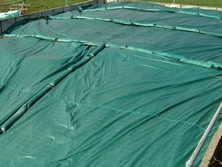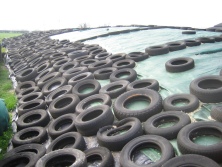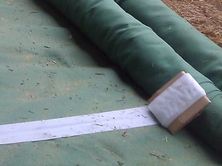Covering Systems for sealing Silage Clamps
Efficient silage making is dependent on effective sealing of the clamp. This is essential. Whilst air is present in the silage the silage cannot ferment. Spoilage, high dry Matter losses and loss of feed value will occur.
It is recommended that the clamp is sealed using and oxygen barrier, side sheets, a protective net and gravel bags or lorry tyre sidewalls.
The purpose of the green protective silage net isn't too apply weight to the clamp surface. It is too protect the plastic sheets from damage which would allow the ingress of oxygen and water. Whilst the heaviest nets are only a few ounces cover 1m2, a lorry tyre sidewall is typically 12-13 kgs / 1m2.
If the clamp does not have a truly air tight seal, then there will be losses and waste
Silage clamps should use protective covers in order to reduce losses due to damage to plastic sheets
RWN Protective Silage Covers and Nets
We offer a wide range of Protective Silage Covers and Nets. These are designed to protect plastic silage sheets and films from holes caused by birds, cats and dogs as well as from any other accidental physical damage which would allow entry of oxygen or water in to the silage pit.
Silage sheets are not airtight if they have holes in them.
Use a protective cover over plastic sheets
Types of Protective Silage Covers
 Silage covers
fall
into 3 distinct categories.
Silage covers
fall
into 3 distinct categories.
- Woven Tight Weave Anti-UV Protective Covers
- Woven Open Weave Protective Covers
- Passion Fleece Covers
Passion Woven Anti-UV Silage Covers
These silo covers are engineered to offer superior UV resistance and tear strength, ensuring your silage remains in peak condition. Close weave, non-slip and are relatively impermeable to wind pressure changes making them an excellent option. They mould well to the silage and are easy to handle.
These are our most anti-slip and most wind proof protective covers. Passion Woven Covers combine economy with durability. These are our best selling protective covers.
Passion Woven Anti-UV Covers.
A cost-effective solution for protecting your silage
 These woven, tight weave protective silage nets have many advantages over most other silage
nets.
They are wind resistant reducing oxygen transmission when used over standard plastic films or
silage
sheets. They are very flexible, forming well to the silage and are easier to handle.
These woven, tight weave protective silage nets have many advantages over most other silage
nets.
They are wind resistant reducing oxygen transmission when used over standard plastic films or
silage
sheets. They are very flexible, forming well to the silage and are easier to handle.
They are non-slip so gravel bags and tyres are less prone to sliding off the slopes. Most importantly anti-UV protective silage nets are much safer to walk on than most open weave nets widely available in the UK.
Trial work at Leeds University has clearly demonstrated that close weave Anti-UV nets are much more effective in reducing oxygen transmission into the clamp than open weave nets and covers. The protective close weave anti-UV net reduced DM losses in the top 30cms of silage due to oxygen transmission from 35% to 8.2% when used on top of two black sheets.
Since they are close weave and keep out daylight they can be used directly over oxygen barrier film without a black sheet and no risk of sunlight degrading the OB film.
Clamp220 Silage Clamp Covers
 A premium green open weave cover woven from from extremely robust, high density, thick, mono-filament polyethylene (HDPE) yarns.
A premium green open weave cover woven from from extremely robust, high density, thick, mono-filament polyethylene (HDPE) yarns.
Clamp 220 Silo covers and bags are made of woven HDPE monofilament yarn with high UV stability which guarantees exceptional robustness and ensures they can be used for many years.
Very high thread thickness,
High quality seams and hems.
Thanks to elaborate weaving, innovative machine technology and the
use of high-quality raw materials, CLAMP220 silo protection covers are
considered amongst the best worldwide.
These 220 g/m2 nets have good sliding resistance and excellent UV stability.
Clamp220 Nets are amongst the most bird proof and longest lasting silage nets available with a typical service life of 10 years or more. They are very durable, offering excellent protection for silage films and sheets.
We recommend Clamp220 nets where birds are a particular problem
 Passion Fleece Silage Covers:
Passion Fleece Silage Covers:
These, advanced, non-woven, fleece covers are thicker and heavier than conventional woven nets.
Fleece silage covers are much more wind resistant, more bird proof and don't move on the silage clamp. The non-fray design which hugs silage contours, offers excellent protection against birds and other physical damage.
The extra thickness gives greater protection against pin-holing of sheets caused by claws of birds and small mammals which may happen with some conventional protected covers.
The unique structure is not affected by wind and repels water. If damaged by machinery they can also be easily repaired. Passion Fabric Hooks can be used for both repairs and to hold the fleece covers in place over large areas.
Passion Fleece Covers are supplied in 6m widths and in various lengths. They can be secured with minimal overlaps using velcro patches or gravel bags. If put length ways on the pit they can be rolled onto 6m lengths of plastic drainage pipe for easy handling.
Fleece Covers are more applicable in situations where an oxygen barrier film is used without a black sheet and also where only minimal amounts of gravel bags, tyres and lorry tyre sidewalls are used to weight the silage pit surface.
Advanced Fleece Covers, an effective alternative to conventional nets
 Gravel Bags
Gravel Bags
Gravel Bags: are highly beneficial especially on outside pits. They have a much heavier footprint than tyres and mould to the silage better along walls, shoulders and at the pit edges. Gravel bags are 1 metre in length when filled and weigh around 25kg.
Lorry Tyre Sidewalls
Whilst lorry tyre sidewalls offer the best option for weighting the whole clamp surface to reduce surface waste. Gravel bags are much more effective than tyres when used against walls, on the ground and along the face. Gravel bags can also be used across the pit at 3 metre intervals as an alternative to tyres.
BETTER SILAGE, REDUCED FEED COSTS, MORE MILK AND LESS HASSLE
More Effective Clamp Sealing Systems
Always use an effective Silage Additive. For advice on Making Better Silage and reducing feed costs, contact Richard Webster.
